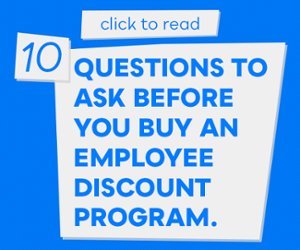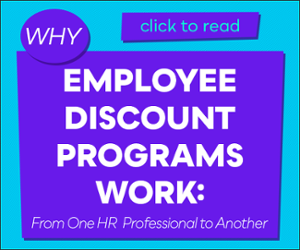Who doesn't love "free" stuff?
But any time we're offered something for free, we can't help but ask, "what's the catch?"
When it comes to employee discount programs, the whole point is to attract and engage your employees and generate goodwill -- no small feat. And some discount programs do that remarkably well. Others simply lack any compelling value and after a few months, your employees will mock the program behind your back, and you're left wondering why nobody uses it.
Whenever we're faced with the choice between something being given to us for free or having to pay for something similar, it's important to ask ourselves the tough questions. Why would someone give away something of value? The answer, my friends, can be summed up in the famous saying, "Follow the money."
The allure of "free" is undeniably strong, but employers who are hoping to snag an incredible discount program without spending a dime will quickly discover that free programs often come with their own sneaky ulterior motives.
What Free Employee Discount Programs Won't Tell You
Here are ten inconvenient truths about "no upfront costs" and "free" employee discount programs that executives should consider before jumping on the bandwagon and offering it as a benefit to employees. These are the facts that they probably won't tell you:
1. It may be free for you, but it's a cash cow for them -- So how do these "free" employee discount programs manage to stay afloat? Well, they make money from every transaction. Using what's known as "affiliate offers," merchants give commissions to referring sites for each trackable transaction made.
So, here's the thing - while these "free" employee discount programs may seem enticing, the truth is that your members end up with measly discounts because these "free" programs are pocketing a significant portion of the discount margin for themselves. They're basically making up for the revenue they didn't get from you when you signed up. And let's be real, with such lackluster discounts, your employees are bound to lose interest in the program sooner or later.
 2. Their deals don't deliver real value to your employees -- The free model incentivizes the discount program provider to push the most profitable deals for them, instead of serving up the deepest discount offers that appeal to your employees. It’s how these free employee discount programs maximize their earnings at the expense of YOUR employees.
2. Their deals don't deliver real value to your employees -- The free model incentivizes the discount program provider to push the most profitable deals for them, instead of serving up the deepest discount offers that appeal to your employees. It’s how these free employee discount programs maximize their earnings at the expense of YOUR employees.
3. They don't offer in-store deals at popular places like restaurants -- That's right, free employee discount programs will use just about any online discounts they can get their hands on. But, they only want discounts that they can make money from, which means you won't find any discounts for restaurants or other in-person experiences. If they can't get a cut of the transaction, they won't bother passing on the discount to your employees. So, don't expect to see any in-store offers popping up with these free programs. They're all about the online discounts, leaving your employees high and dry when it comes to local restaurants and retailers.
4. They want you to believe they have many in-store locations -- Discount programs are quite clever when it comes to in-store offers. They have their ways of making it seem like they've put in the hard work to create a vast network of in-store discounts. Instead of disclosing the number of physical locations they have, they'll claim to have a bazillion "discounts" or "ways to save." They'll even use some creative math to make their network seem larger than it actually is. This makes it nearly impossible to make a fair comparison between different discount programs. But hey, that's exactly what they want.
5. The deals are public and forgettable -- The deals being served by cheap and free employee discount programs usually aren’t exclusive or even unique. They’re freely available to the public at large through online shopping searches, daily deal providers, and deal aggregators. Your employees will quickly realize that the so-called "Back to School" sale in your free discount program is nothing more than a cleverly disguised marketing campaign.
6. Your employee data is being exploited for profit -- Free employee discount programs have no reservations about selling your employees' usage and redemption data to a plethora of eager buyers. They may mention this practice somewhere in their contract, but you'll need a magnifying glass to find it among the mountains of convoluted legal jargon. And sometimes, they conveniently "forget" to mention it altogether.
7. Good luck getting any help! -- Sooner or later, one of your employees is going to run into a problem trying to redeem an offer or they might have a question about how to use a discount. But guess what? Free employee discount programs don't offer any customer service. They wash their hands of any responsibility once you've signed on the dotted line. They'll even admit that they're just a third party without any control or influence. So, don't expect any assistance. Your members are left to fend for themselves and don't be surprised if your HR department ends up being bombarded with calls to help address your employees' issues. It's like a game of hot potato, but the potato is an angry employee. Good luck with that!
8. They don’t have a direct relationship with the merchants -- Who needs a direct relationship anyway? I mean, why would you want someone who can actually solve problems?
Plus, major retailers like to keep their best deals under wraps, only sharing them with certain exclusive channels. They don't want just anyone getting their hands on these juicy discounts. So, while these free employee discount programs rely on public deals, your employees will never have access to those secret, password-protected networks where the real savings are hiding.
9. Your employees will be spammed -- Many free employee discount programs have no qualms about bombarding members with an overwhelming number of marketing emails. They employ questionable tactics, such as ignoring unsubscribe requests or using a confusing opt-out process, making it nearly impossible for your employees to stop receiving these emails. This can quickly wear on your employees and unfortunately, it may reflect negatively on you as the employer.
10. Brace yourself for complicated point schemes -- Oh, the joy of earning points! Some free employee discount programs try to spice up their lackluster discounts by offering employees the chance to accumulate points with their purchases. Sounds enticing, right? But what these programs conveniently forget to mention is that the point threshold required to actually earn a reward is ridiculously high. Most employees will never reach it. So, while your employees may initially get excited about earning points, they'll soon start pointing fingers at you because they can't accumulate enough to actually get something worthwhile.
What's In A Benefit?
Nowadays, your employees are constantly on the lookout for ways to boost their financial situation. Employee loyalty is becoming rare these days. According to one study, it is estimated that at any given time, two-thirds of workers are either open to new opportunities or actively searching for their next job.
That means a truly meaningful lifestyle benefit your company offers can not only help you attract new employees but also retain your existing employees. In addition, a powerful lifestyle benefit can also drive bottom-line revenue. According to Demand Metric, companies that can engage over half of their employees will retain over 80% of their customers.
While free and cheap programs may seem tempting, they won't make a significant impact on employee engagement or retention. In fact, it's better to avoid launching such a discount program if it ends up frustrating your employees. Not only will it reflect poorly on your business, but it will also reflect poorly on those who advocated for the program within your company or organization.
Putting Your Money Where Your Mouth Is (And Reaping the Rewards)
The whole point of having an employee discount program is to foster some good vibes between employers and employees by helping them save some serious cash. But in order to achieve that, you need to 1) offer discounts that actually matter, 2) market the program responsibly to encourage participation, and 3) provide top-notch customer service. Without these crucial elements, your discount program will simply fall flat and fail to keep your employees excited and engaged in the long run.
The great news is that a compelling employee discount program can work wonders for engagement and it won't break the bank. It's as affordable as treating your employees to a small candy bar each month. And when your average employee can consistently save hundreds of dollars with this benefit, it offers a return on investment that no other benefit can match. Plus, it's an inclusive lifestyle benefit that equips every employee with a powerful tool to stretch their paychecks.





